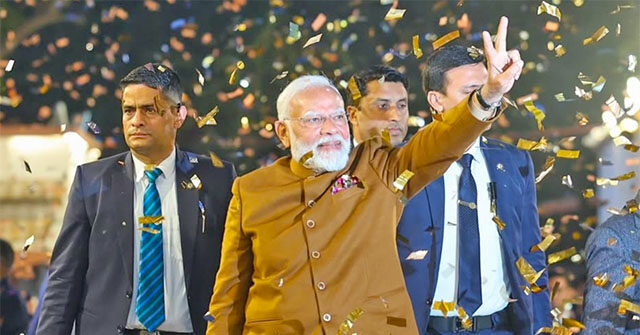India reported 7.4 percent economic growth between January and March 2025, coming in much higher than analyst predictions of 6.7 percent growth, and also much better than the 5.4 percent growth claimed by its regional rival China.
It is always good practice to put an asterisk next to any figures released by the duplicitous Chinese government, but with that in mind, the Chinese National Bureau of Statistics posted 5.4 percent growth for the first quarter, congratulating “the strong leadership of the Central Committee of the Communist Party of China (CPC) with Comrade Xi Jinping at its core.”
The Chinese public certainly does not appear delighted with the recent performance of the economy.
India, on the other hand, exceeded expectations with a first-quarter surge that brought its growth for the fiscal year up to 6.5 percent – the fastest growth of any major economy in the world. India’s fiscal year ended in March.
Much of this growth was driven by higher consumer spending, while China has been struggling for years to get consumer spending up. Inflation is low and weather predictions for monsoon season are promising, which is a major boost to consumer confidence in India’s agrarian economy.
In fact, the BBC dug into the economic figures and noticed rural growth has been surging due to good weather and strong harvests, while urban consumption is relatively weak due to “high unemployment and lower wages.” Also, too much of India’s GDP growth is fueled by massive government spending on infrastructure, rather than private investment.
The course of the coming fiscal year could be determined by the outcome of India’s bilateral trade negotiations with the United States. President Donald Trump applied tariffs of up to 27 percent on Indian goods in April, but then granted a 90-day pause that will expire in July.
President Trump’s exasperation with China this week could be good news for India, since the resumption of Trump’s sky-high tariffs on China would naturally push more business in India’s direction.
Finance Minister Nirmala Sitharaman touted India’s perch atop the list of fastest-growing economies in the world for the past four years running as a sign that Prime Minister Narendra Modi’s policies are working, and the world is embracing India as a new economic superpower.
“We are standing out, compelling the world to look at India with a certain sense of awe. We are in that part of India’s history where it just requires confidence in our country’s abilities and belief that we can deliver the goal which Prime Minister Narendra Modi, on behalf of all the citizens, has laid out,” she said Friday.
“We need to be futuristic, and the kind of progress that we are seeing for every such investment assures me that with the industry being leaders in such an area, we are sure to reach our 2047 goal of becoming Viksit Bharat,” she said.
Viksit Bharat 2047 is Prime Minister Modi’s roadmap for transforming India into a fully developed First World nation with a $30 trillion economy in time for the 100th anniversary of Indian independence. The name of the program translates to “Developed India.”
Viksit Bharat is also unabashedly a political agenda, as it includes the goal of winning an overwhelming number of seats in the Lok Sabha, the lower house of India’s parliament, so that Modi’s economic agenda can be implemented.
According to data from the International Monetary Fund (IMF), India surpassed Japan to become the fourth-largest economy in the world this year, trailing only the United States, China, and Germany. If India’s growth – and Germany’s stagnation – continue at today’s pace, India will pass Germany to become the world’s third-largest economy in 2028.
India’s leaders may also be pleased to know their economy is far outperforming that of Pakistan, the neighbor they almost went to war against earlier this month. Pakistan was the richest country in the region 50 years ago, but poor economic policies, political instability, and explosive population growth have weakened it tremendously.
Pakistan’s economy grew at an anemic 2.4 percent in the third quarter, and appears to have stalled out completely in the home stretch, leaving it with 2.68 percent for the fiscal year – far below the 3.6 percent anticipated by Islamabad. As with India, Pakistani agriculture benefited from good weather, but its industrial output sank by 1.14 percent.
Read the full article here


